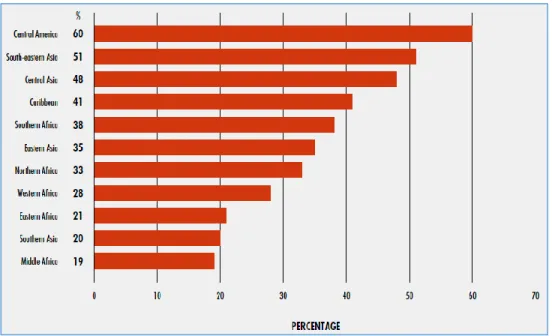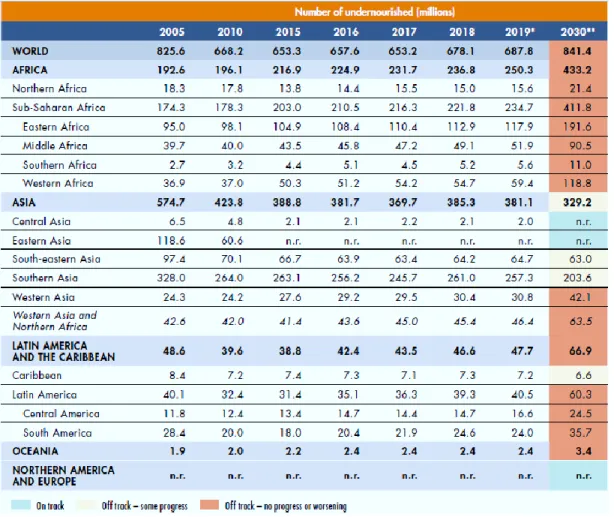It is clear that tackling the poverty and malnutrition that plague the African continent and parts of the world makes good sense to accelerate inclusive growth and development. By leveraging the proliferation of superfoods and robust technology that is inclusive and scalable, we have a good opportunity to build better mechanisms to fight malnutrition and poverty in the world. In consultation with the World Bank, Sub-Saharan Africa was identified as the second largest country with hungry people compared to Asia with 512 million people (FAO, 2013).
The World Health Organization (WHO) reveals that 1 in 3 people in developing countries face mineral and vitamin deficiencies (Adeyeye et al., 2017; WHO, 2018) causing the increase in malnutrition. The mineral and vitamin deficiency situation in children is not surprising because many children in the world do not meet the minimal dietary diversity with the highest in Central America (Figure 1). Many years ago, the world committed to ending hunger, forms of malnutrition and food insecurity, until now, just a few years until 2030, we are still on track to reach the set goal.
Research and data show that the world is not making rapid progress in addressing access to nutritious and sufficient food for a growing population. It is more likely that if the council does not act quickly; hunger, food shortages and malnutrition would continue to grow at an unprecedented rate, leading to compromised psychophysical and intellectual development of the children of the future. With only nine years until 2030, projections with the impact of COVID-19 show that the world is at risk of meeting the SDG targets on hunger and malnutrition.
The preliminary analysis in Table 2 shows that the COVID-19 pandemic has already distorted the food supply chain around the world and is predicted to expose nations to an increase in hungry people as there is already an imbalance of demand and supply in food value chains.

GLOBAL INSIGHTS OF MORINGA OLEIFERA (DRUMSTICK)
13 India, Japan and China.6 "Indian Moringa (drumstick) powder, henna powder, chili, value-added tea have caught the fancy of the country's second largest trading partner China, and the Asian giant is eager to import these agricultural products from India."7 Major industry players, including Kuli Kuli, Ancient Greenfields and Earth Expo, are unable to meet their presence in a new approach to consumer strength, among others, and their presence is increasingly meeting their new approach. . Based on this perspective, we see that leveraging an already robust technology could unlock the potentials of Moringa industry players to revolutionize the Moringa value chain as a viable strategy to improve the nutritional status of the world's galloping population that leaves no one behind. Despite Moringa's potential to curb malnutrition in Ghana and the rest of the world, its value chain in Ghana is underdeveloped with constraints including subsistence production, unorganized producers, limited or weak access to quality inputs, as well as technical support to support farmers to thrive.
The situations require restructuring and formalization of the value chain to meet market demand to address malnutrition. Secondly, the value chain of the Moringa chain is also seen as underdeveloped in Malawi, which makes scaling up the value chain in Malawi unattractive. Based on this, the 2020 study by Sagona et al. pinpointed innovations as a critical way to add value to the Moringa strain and value chain as it would be.
Additionally, a recent 2020 Farm Africa study found that the Moringa value chain in Tanzania is limited by unreliable markets, lack of credit, use of old-fashioned equipment and limited available packaging materials. The problem is attributed to limited or no linkages between actors in the value chain to ensure timely access to information, transparency and fair pricing.
OUR APPROACH
It is a simple mobile app that supports small farmers with advanced information, markets, finances and rationalizes work for all actors in the value chain. Its adoption would revolutionize the Moringa value chain in Ghana with real-time information, the data-driven decision-making on soil management analysis, crop management, marketplace and finance and risk management (Figure 2) while ensuring end-to-end traceability to solve the complex challenges of lack of access (knowledge, markets, services) by all actors in the value chain. On this basis, financial institutions would be in the best position to use data and insights about farms and farmers in expanding the credit base based on their ability to assess each farmer's risk.
We leverage existing field workers in communities as Agro Entrepreneurs who are tech savvy and have access to a smartphone to act as a broker with Moringa farmers in the community. Agro-entrepreneurs are trained to digitally assist smartphone- or smartphone-less Moringa farmers in using the platform to access real-time insights on agricultural cycle planning, soil nourishment, markets and value chain credit to increase productivity and income gaps (Figure 4), see Appendix 3, the basic scheme of the Farmex approach. The idea of Agro-entrepreneurs is to foster trust to promote farmer inclusiveness, acceptance and performance throughout the supply chain.
Through Farmex, all stakeholders within the value chain would know where Moringa raw materials come from, how Moringa finished products are produced and who uses them. Farmex has the potential to aid data acquisition, smart farming, improved farmer portfolio management and informed insights (Figure 5) for policy decisions across the Moringa value chain. New farmers register in the farmers menu and to register new farmers, Agro entrepreneurs help new entrants to register by clicking on the farmers menu in B' and then the "Register your farmer" button in C".
Moreover, small farmers would have access to available markets for their produce and finance to increase their productivity. Similarly, the Farmer Profile menu on F' allows all registered farmers to edit or update their bio details as and when available. Farmers would also have access to notifications shared on the platform, the ability to change their password as a security measure.
One aspect of the platform is its ability to scale across different geographies and farming ecosystems. Stakeholders will have the ability to manage all transactions with farmers through the web and mobile interface. Across the value chain, better real-time data will enable improved decision-making for financial institutions and other stakeholders.
All stakeholders have a source of data that can be tracked along the value chain. Partner with a research institution and other NGOs working in the field of Moringa to develop an annual research program for young graduates to undertake more research on Moringa.

BENEFITS OF ADOPTING FARMEX-MORINGA VALUE CHAIN
The annual emission reduction potential resulting from reduced use of synthetic fertilizers is 0.07 tCO2e/ha.
OUR KEY PARTNERS TO TRANSFORM MORINGA VALUE CHAIN
CONCLUSION
Multifaceted Uses of Different Parts of Moringa Species: A Review of Current Status and Future Potentials. Reaching deep into low-income markets Companies achieving impact, sustainability and scale at the bottom of the pyramid. Effect of moringa oleifera on blood glucose, LDL levels in obese people with type II diabetes.
Conditional Acceptance of Digitized Business Model Innovation at the BoP: An Analysis of eKutir Stakeholders in India. Moringa oleifera: An unknown crop in developed countries with great potential for industry and adapted to climate change. Levels and Trends in Child Malnutrition: Key Findings of the 2020 Edition of the Joint Assessment of Child Malnutrition.
APPENDICES Appendix 1
The oil is said to have a pleasant taste similar to olive oil. The oil from the seeds has also been used as an industrial oil popularly known as Ben or Behen in the oil trade. Pounded Moringa seeds can be used for small-scale water purification, especially in rural areas where there is a great need to improve water quality to avoid the risk of using contaminated water and water-borne diseases. Moringa trees are one of the best multi-purpose trees for use in spawning cropping systems.

